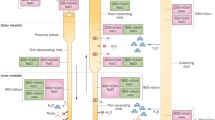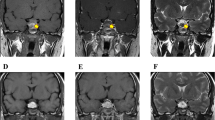Abstract
A decrease in urine volume is considered the therapeutic goal of the treatment of central diabetes insipidus (DI) with desmopressin (dDAVP). A low urine volume is a risk factor for kidney stone formation. This is the first report of nephrolithiasis in association with DI. It is likely that successful therapy with dDAVP and the patient’s own purposeful decreased fluid intake contributed to calcium oxalate stone formation. Prevention of stone recurrence requires an increase in urine volume. The patient’s compliance with this recommendation led to an episode of acute hyponatremia, a well-known complication of dDAVP therapy. The challenge of the management of stones in the setting of DI requires balancing the conflicting goals of both decreasing and increasing urine volume.
Similar content being viewed by others
References
Borghi L, Meschi T, Amato F, Briganti A, Novarini A, Giannini A (1996) Urinary volume, water and recurrences in idiopathic calcium nephrolithiasis: a 5-year randomized prospective study. J Urol 155: 839
Rizzo V, Albanese A, Stanhope R (2001) Morbidity and mortality associated with vasopressin replacement therapy in children. J Pediatr Endocrinol Metab 14: 861
Odeh M, Oliven A (2001) Coma and seizures due to severe hyponatremia and water intoxication in an adult with intranasal desmopressin therapy for nocturnal enuresis. J Clin Pharmacol 41: 582
Baylis PH (2001) Vasopressin, diabetes insipidus, and the syndrome of inappropriate antidiuresis. In: DeGroot LJ, Jameson JL (eds) Endocrinology, 4th edn. W.B. Saunders, New York, pp 363
Kinter LB, McDonald J, Beeuwkes R, Gittes R (1982) Urolithiasis in rats with diabetes insipidus (Brattleboro strain rats). J Urol 128: 1077
Green RP, Landt M (2002) Home sodium monitoring in patients with diabetes insipidus. J Pediatr 141: 618
Mannucci PM (2004) Treatment of von Willebrand’s disease. N Engl J Med 351: 683
Neely DE, Plager DA, Kumar N (2003) Desmopressin (DDAVP)-induced pseudotumor cerebri. J Pediatr 143: 808
Halperin ML, Bohn D (2002) Clinical approach to disorders of salt and water balance. Emphasis on integrative physiology. Crit Care Clin 18: 249
Lopes T, Dias JS, Marcelino J, Varela J, Ribeiro S, Dias J (2001) An assessment of the clinical efficacy of intranasal desmopressin spray in the treatment of renal colic. BJU Int 87: 322
Author information
Authors and Affiliations
Corresponding author
Rights and permissions
About this article
Cite this article
Mehandru, S., Goldfarb, D.S. Nephrolithiasis complicating treatment of diabetes insipidus. Urol Res 33, 244–246 (2005). https://doi.org/10.1007/s00240-005-0469-3
Received:
Accepted:
Published:
Issue Date:
DOI: https://doi.org/10.1007/s00240-005-0469-3




